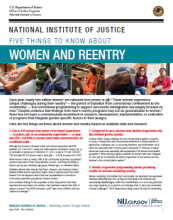Female
De-escalation Training: What Works, Implementation Lessons, and Taking It to Scale; Plenary at the 2023 NIJ Research Conference
Date Published
2023
Agencies
NIJ
Supporting Women’s Reentry from Incarceration: Discussing Promising Practices & Future Research
Date Published
2023
Agencies
NIJ
Five Things to Know About Women and Reentry
Date Published
April 2024
Agencies
NIJ
Supporting Women’s Reentry from Incarceration: A Discussion of Promising Practices and Opportunities for Future Research
Event Dates
–
Eastern
Location
Online
Event Type
Webinar
Registration Status
Not Required
The Glueck Women: Using the Past to Assess and Extend Contemporary Understandings of Women's Desistance From Crime
Date Published
2017
Agencies
NIJ-Sponsored



